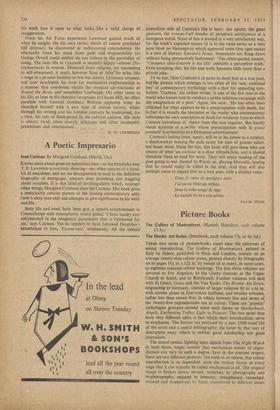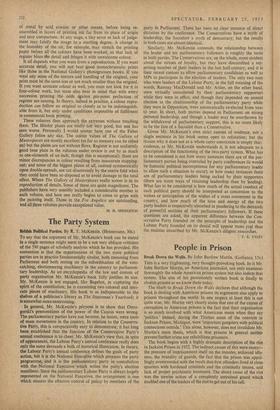Picture Books
The Herder Art Series. (Interbook, each volume 15s. or 6s. 6d.)
THESE two series of picture-books stand near the extremes of oolour reproduction. The Gallery of Masterpieces, printed in Italy by Sidera, published in Paris and London, contain on an average twenty-nine colour plates, printed directly by lithography on to pages 163 in. x 12* in. by means of as many, in some cases, as eighteen separate colour workings. The first three volumes arc devoted to Fra Angelico, to the Giotto frescoes in the Upper Church at Assisi, and to Rembrandt. Further volumes will deal with El Greco, Goya and the Van Eycks. The Herder Art Series, originating in Germany, consists of larger volumes 83 in. x 61 in. with sixteen plates in four-colour halftone, and smaller volumes, rather less than crown 8vo, in which between five and seven of the twenty-five reproductions are in colour. These are 'popular' anthologies grouped around some such theme as Motherhood, Angels, Enchanting Trifles, Light in Pictures. The two series thus have very different aims, a fact which their introductions serve to emphasise. The former arc prefaced by a taut 3,000-word life of the artist and a useful bibliography; the latter by that sort of descriptive essay which is neither good scholarship nor good journalism.
The casual reader, lighting upon details from The Night Watch in both series, might wonder that mechanical means of repro- duction can vary to such a degree. Save in the coarsest respect, these are two different pictures. The truth is, of course, that colour reproduction is so dependent upon the human factor at every stage that it can scarcely be called mechanical at all. The original image is broken down, shrunk, stretched, by photography and re-photography, reduced in intensity, strengthened, retouched, masked and stopped-out by hand, transferred to different sheets
of metal by acid erosion or other means, before being re- assembled in layers of printing ink far from its place of origin and easy comparison. At any stage, a tiny error or lack of judge- ment may falsify the image to a startling degree. A change in the humidity of the air, for example, may stretch the printing paper before all the colours have been worked, so that lack of register blurs the detail and fringes it with unwelcome colour.
It all depends what you want from a reproduction. If you want accurate detail, you will not beat good monochromatic prints like those in the National Gallery's photogravure books. If you want any sense of the texture and handling of the original, your print must be the same size or not much smaller than the original. If you want accurate colour as well, you must not look for it in four-colour work, but must also bear in mind that with every successive printing the odds against pin-point perfection of register are soaring. In theory, indeed in practice, a colour repro- duction can follow an original so closely as to be indistinguish- able from it, but only under conditions impossible of fulfilment in commercial book printing.
These volumes then approach the extremes without touching them. The Herder plates are really not very good, but one has seen worse. Personally I would sooner have one of the Faber Gallery folios any day. The colour values of The Gallery of Masterpieces are mostly excellent (as far as memory can be relied on) but the plates are not without flaws. Register is not uniformly good (one plate in the volumes under review is out by as much as one-sixteenth of an inch, though this is exceptional); there are minor discrepancies in colour resulting from inaccurate stopping- out; and some of the biggest plates of all, centred symmetrically upon double-spreads, are cut disastrously by the centre fold when they could have been so disposed as to avoid damage to the total effect. Where The Gallery of Masterpieces really scores is in its reproduction of details. Some of these are quite magnificent. The publishers have very sensibly included a considerable number in each volume, and here one really begins to come to grips with the painting itself. Those in the Fra Angelico are outstanding, and all three volumes provide exceptional value.











































 Previous page
Previous page